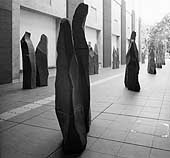|
Inspiration That Comes Naturally
By ROBERT YELLIN
for The Japan Times, April 22, 2000
Nature, that miraculous giver of life, has been a source of inspiration for many Japanese artists, potters included, for many a century. Whether it be in floral motifs or the naturalness of their chosen materials or birds in flight, nature has played a conscious role in shaping the thoughts and vessels of Japanese potters.
This is due in part to the way of tea and its connection with Zen; it's been said that there is no tea without Zen. Yet some potters have forsaken the cherished chawan (tea bowl) and still find inspiration from nature in other ways, by re-creating forms in the natural world like mountains, stones, rippling water, vegetables or snow.
 One such Japanese ceramic artist is Sugiura Yasuyoshi, who is showing his wonderfully creative pottery at Nihonbashi Mitsukoshi's sixth-floor gallery until April 24, 2000. Titled "To no Hakubutsu Shi (Ceramic Natural History Exhibition)," Sugiura's exhibition is alive with forms and motions more often found at the seashore, on a walk through the woods or a garden than in a prestigious gallery. Pastel-colored shells or kinetically vibrant sea urchins (uni -- love that sushi, don't you?) reach out to the viewer in surrealistic ways, particularly the uni, the moss and the durian trees' seed. One such Japanese ceramic artist is Sugiura Yasuyoshi, who is showing his wonderfully creative pottery at Nihonbashi Mitsukoshi's sixth-floor gallery until April 24, 2000. Titled "To no Hakubutsu Shi (Ceramic Natural History Exhibition)," Sugiura's exhibition is alive with forms and motions more often found at the seashore, on a walk through the woods or a garden than in a prestigious gallery. Pastel-colored shells or kinetically vibrant sea urchins (uni -- love that sushi, don't you?) reach out to the viewer in surrealistic ways, particularly the uni, the moss and the durian trees' seed.
The latter is quite medieval looking and reminds me of a knights' lance, while the moss pieces, with their tubular appendages, are caught in frozen motion. Never thought I'd see these in a ceramic exhibition.
Sugiura's work is known mostly as saimon-ki (colorful vessels), using pastel greens, reds and yellows reminiscent of fresco paintings, the clay looking like the walls of ancient cathedrals. The forms in the current exhibition almost all have this saimon color scheme. A few are two-tone in white and brown, these being the acorn group from various trees.
Sugiura graduated from the Tokyo National University of Fine Arts and Music in 1973 and is best known for his large stone form (to-seki) installations that can be found in many museum gardens throughout Japan, including the Tochigi and Gifu Prefectural Museums and the Aichi Ceramic Art Museum. They resemble figures from Easter Island or the stones of Stonehenge.
Work by Sugiura Yasuyoshi
from "Ash-Covered Ceramic Stones" series
Photo by Hatayama Takashi
Two can be seen at the entrance of Suigyoku (03) 3961-8984, a fine ceramic gallery located in Itabashi that also displays Sugiura's smaller works as well as many other contemporary potters. During a recent phone call to Sugiura he mentioned the word yo to me and I was quite surprised to hear that term in connection with his current exhibition. Yo is very much in vogue in the art world, particularly the Mingei world, with the gist being that the beauty of an object is found through use.
Sugiura believes this to be true, but for him the use of his natural forms in simply being displayed carries as much meaning as is in a bowl (preferably made by him) placed on the table full of vittles. He feels this way of displaying his work will activate a more seishin-teki or spiritual realm within the viewer because they will have to ponder the piece a bit more deeply, visually and spiritually.
He also wants to refrain from calling his work "objets," for that implies a sculptural world void of yo. So he has chosen to call his work utsuwa (ki) or vessels. It does appear to be a contradiction, for his pieces do have a very sculptural feel, but there are openings for water and some of the works could be artistically used as vases.
All in all about 50 works will be on display and for sale, and it will make a nice change of setting from the actual walk on the beach or through the woods. Sugiura's "natural history museum" becomes extinct in a few days, so take the walk while you can.
The Japan Times: April 22, 2000
(C) All rights reserved
For more on this artist, please visit:
- Sugiura Yasuyoshi (Clay Flowers)
- Interview with Sugiura Yasuyoshi
.
|